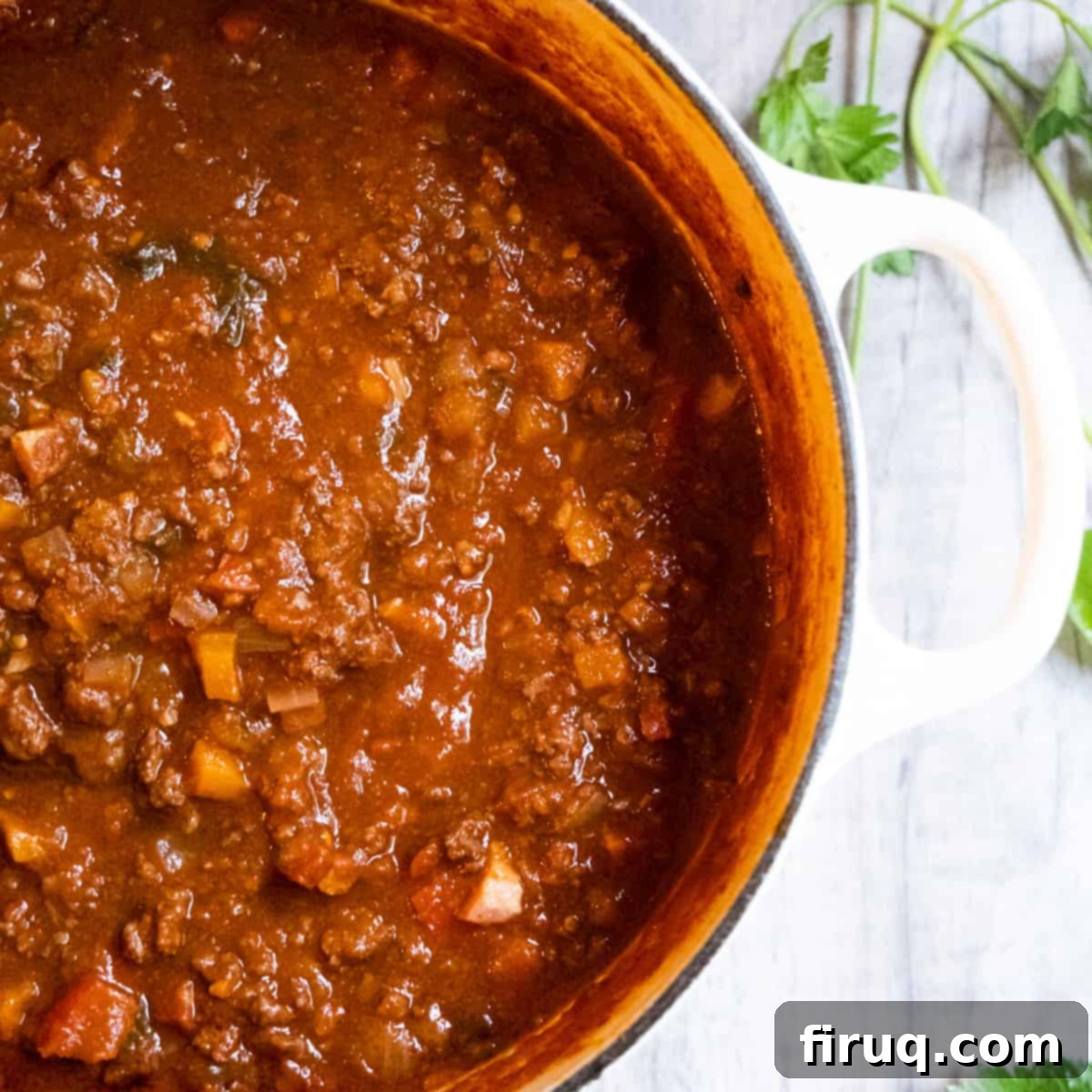Authentic Slow-Cooked Bison Ragu: A Hearty and Healthy Italian Pasta Recipe
What’s better than a rich, deeply flavorful, and incredibly healthy bison ragu simmered to perfection and served over your favorite type of pasta? This classic Italian dish, reimagined with lean and nutrient-dense bison, offers a comforting meal that’s both satisfying and packed with goodness. Prepare to fill your home with an aroma that promises an unforgettable dining experience.
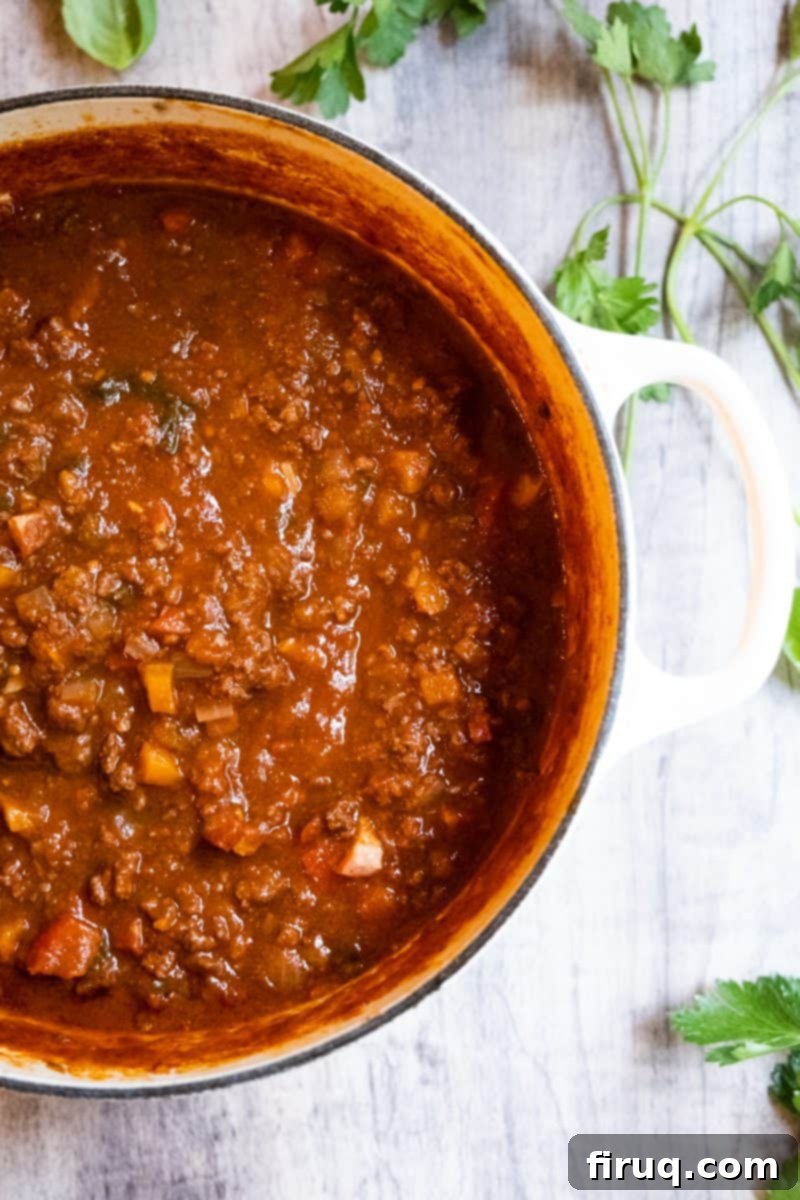
While often compared to beef, bison stands out as an excellent and increasingly popular choice for a hearty ragu. It’s naturally leaner, offering a robust flavor that is slightly sweeter and less gamey than you might expect. Beyond its delicious taste, bison is a nutritional powerhouse, providing a rich source of essential nutrients like vitamin B12, zinc, iron, and selenium. It also contains beneficial omega-3 fatty acids and is notably lower in saturated fats compared to beef, making it a healthier alternative for your family’s table.
If you enjoy experimenting with different meats in your culinary creations, you might also love our Quick Lamb Ragu with Pappardelle, another fantastic slow-cooked dish that highlights the versatility of braising.
[feast_advanced_jump_to]
Why This Bison Ragu Recipe Will Become Your Favorite
Making a ragu is truly an art form, and it’s particularly well-suited for meats that can typically be tougher or leaner. Bison, with its lean profile, benefits immensely from the slow braising process, transforming into melt-in-your-mouth tender strands of meat that perfectly coat your pasta.
This recipe isn’t just about the bison; it’s about mastering the foundational techniques that make any ragu exceptional. Much like our beloved Authentic Bolognese and our indulgent Italian Short Ribs with Gnocchi, this bison ragu is a prime example of how patient, slow cooking can elevate humble ingredients. And here’s a secret: you’re not strictly confined to bison! This versatile technique works wonderfully with other red meats such as lamb, elk, beef chuck, or even a blend of ground meats and sausage, allowing you to adapt it to your preferences or what you have on hand.
Growing up, a “sauce” without meat was simply unheard of in our home. Every Sunday, my dad would craft some form of ragu, always insisting that the heart of a truly great Sunday Sauce lay in the quality and quantity of the meat. I couldn’t agree more; the meat isn’t just an addition, it’s a “cheat code” that infuses the sauce with incredible depth and umami, developing a flavor profile that simmered-alone tomatoes simply cannot achieve.
However, there’s a little more to it than just the meat. The process involves layers of flavor building: the deep caramelization of the tomato paste, the careful balance of a traditional soffritto (sautéed onions, celery, and carrots), and the slow simmering of the meat in rich red wine. These nuanced steps are crucial. They’re what transform a simple sauce into a phenomenal culinary creation that your family will adore. Layering in all the right ingredients and allowing them time to meld always leads to a deeper, more complex flavor, much like the rich tapestry of tastes you find in our Beef and Barley Soup with Mushrooms.
Essential Ingredients & Smart Substitutions for Your Ragu
Crafting a truly memorable ragu starts with understanding your ingredients. While this recipe highlights bison, many components offer flexibility. Always aim for the highest quality ingredients you can find, as they significantly impact the final flavor of your slow-cooked sauce.
- Bison: As the star of this “Bison Ragu,” ground bison offers a lean yet incredibly flavorful base. Its slightly sweet and robust taste marries beautifully with the rich tomato sauce. However, as mentioned, this recipe is highly adaptable. Feel free to substitute with ground lamb, elk, beef (chuck or sirloin for a leaner option), or even Italian sausage if bison isn’t readily available or you’re looking for a different flavor profile. The braising method ensures tenderness regardless of the red meat chosen.
- Whole Plum Tomatoes: For an authentic Italian ragu, whole plum tomatoes (preferably San Marzano if you can find them) are my top choice. They offer a superior, sweeter flavor and a better texture once crushed, allowing you to control the consistency of your sauce. While you can substitute with crushed tomatoes for convenience, or sieved tomatoes for an even smoother sauce, starting with whole plums provides a fresh, bright tomato taste that truly shines.
- Extra Virgin Olive Oil (EVOO): The foundation of any good Italian sauce begins with quality olive oil. Use a high-quality EVOO like Partanna. A good olive oil adds depth and a slightly peppery note, contributing significantly to the overall flavor of the ragu. It’s not just a cooking fat; it’s an ingredient that enhances every layer.
- Dry Red Wine: This is a non-negotiable for a truly rich ragu. Always use a decent, dry red wine – something you would enjoy drinking. Italian varietals like Chianti, Sangiovese, or even a robust Merlot or Cabernet Sauvignon work wonderfully. The alcohol evaporates during cooking, leaving behind concentrated, complex flavors that deepen the sauce’s character. If you prefer not to cook with wine, a good quality beef or vegetable broth can be used as a substitute, though the flavor profile will be slightly different.
- Pancetta: Cubed pancetta provides a crucial layer of flavor and richness. As it renders, it releases savory fat that becomes the base for sautéing your vegetables, and its crispy bits add textural contrast to the finished dish. If pancetta is hard to find, good quality unsmoked bacon can be a suitable alternative.
- Mirepoix (Onion, Celery, Carrots): This aromatic trio is the soul of many classic sauces. Finely chopping your onions, celery, and carrots ensures they break down fully during the long simmer, infusing the sauce with their sweet and earthy notes without leaving large chunks.
- Garlic & Fresh Basil: These are classic Italian aromatics. Freshly minced garlic adds pungent warmth, while a generous handful of fresh basil contributes a bright, herbaceous freshness that is essential to a good tomato-based ragu.
*Please see the recipe card below for specific measurements and quantities of all ingredients.
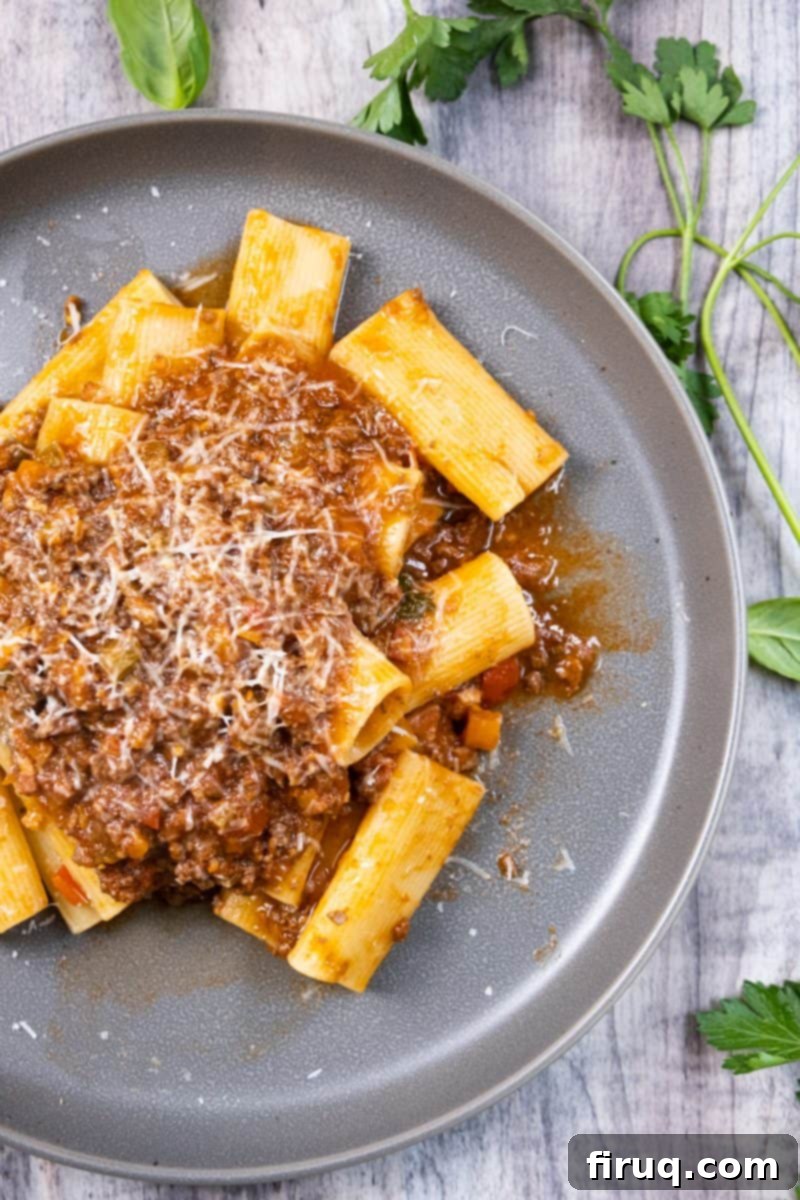
Crafting Your Perfect Bison Ragu: A Step-by-Step Guide
The journey of making ragu is almost as enjoyable as eating it, primarily due to the amazing aroma that will permeate your house for hours. It smells almost as good as it tastes, setting the stage for a truly comforting meal. Follow these steps for a rich and tender bison ragu.
1. Sautéing Pancetta and Building the Soffritto
Begin by adding the chopped pancetta to a large saucepan or Dutch oven over medium heat. The key here is to start with a cold pan and gradually bring it to temperature; this allows the fat to render slowly and thoroughly, resulting in perfectly crispy pancetta and a flavorful fat base. Stir often until the pancetta is beautifully golden brown on all sides. Once rendered and crispy, use a slotted spoon to remove the pancetta and set it aside, leaving just a small amount of its flavorful oil in the pot. Add 2 tablespoons of EVOO to the pan, then stir in your finely chopped onion, celery, and carrots (your soffritto). Add a generous pinch of salt to help draw out moisture and intensify flavors. Sauté these vegetables until they are soft and the onions are translucent, about 8-10 minutes. Finally, stir in the minced garlic and sauté for just 2 more minutes until fragrant. Be careful not to burn the garlic, as it can turn bitter.
2. Browning the Bison and Caramelizing Tomato Paste
Next, add the ground bison directly to the sautéed vegetables. Use a spoon to break apart the meat into smaller pieces. Add another pinch of salt to season the bison. Cook the bison until it is just browned, stirring frequently. Don’t overcrowd your pot; if you have a large amount of bison, brown it in batches to ensure it sears rather than steams. You might notice some liquid accumulating in the pot; this is normal. Continue stirring until the liquid evaporates and the meat takes on a nice brown color. Once the bison is browned, stir in the tomato paste, ensuring it coats all the meat and vegetables. Allow it to cook and caramelize for 2-3 minutes, stirring constantly. This step is crucial, as caramelizing the tomato paste deepens its flavor, adding a rich, complex sweetness to your ragu. Then, pour in the red wine and bring the mixture to a simmer. Let it simmer gently until the red wine has almost completely absorbed, which typically takes about 6-8 minutes. This process, known as deglazing, lifts all the flavorful browned bits from the bottom of the pan, adding another layer of depth.
3. Simmering the Rich Sauce to Perfection
Now, it’s time to bring everything together for the long simmer. Using your hands or an immersion blender, gently crush the whole plum tomatoes directly in their can or in a bowl, breaking them down into a rustic sauce consistency. Pour the crushed tomatoes into the pot with the bison mixture and return the entire sauce to a gentle simmer. Add the reserved crispy pancetta, the fresh basil, and another pinch of salt. Stir everything together, then cover the pot slightly and reduce the heat to low. Allow the sauce to simmer for a minimum of 2-3 hours. The longer it simmers, the more the flavors will meld and the more tender the bison will become. Check the sauce every 15-20 minutes, giving it a stir to prevent it from sticking to the bottom of the pot. If you notice the sauce becoming too dry, add a small amount of water or beef broth to maintain a good consistency. This slow simmer is where the magic truly happens, transforming simple ingredients into a rich, complex, and incredibly flavorful ragu.
4. Bringing Sauce to Pasta: The Grand Finale
About 15-20 minutes before the ragu is finished simmering, bring a large pot of salted water to a rolling boil. Add your chosen pasta (rigatoni, pappardelle, or tagliatelle are excellent choices for ragu) and boil as directed on the package until al dente. Before draining, scoop out about ½ cup of the starchy pasta water. Add this pasta water to the simmering ragu and stir; the starch helps to emulsify the sauce, making it cling beautifully to the pasta. Drain your cooked pasta and immediately add it to the ragu in the Dutch oven. Stir until every strand of pasta is thoroughly coated with the rich sauce. Serve your bison ragu generously topped with grated Pecorino Romano cheese and, for the ultimate Italian experience, a big, crusty loaf of Italian bread for dipping. The combination is pure perfection!
If you’re looking to skip the pasta, this flavorful ragu is also absolutely divine served over a creamy bowl of Classic Creamy Polenta!
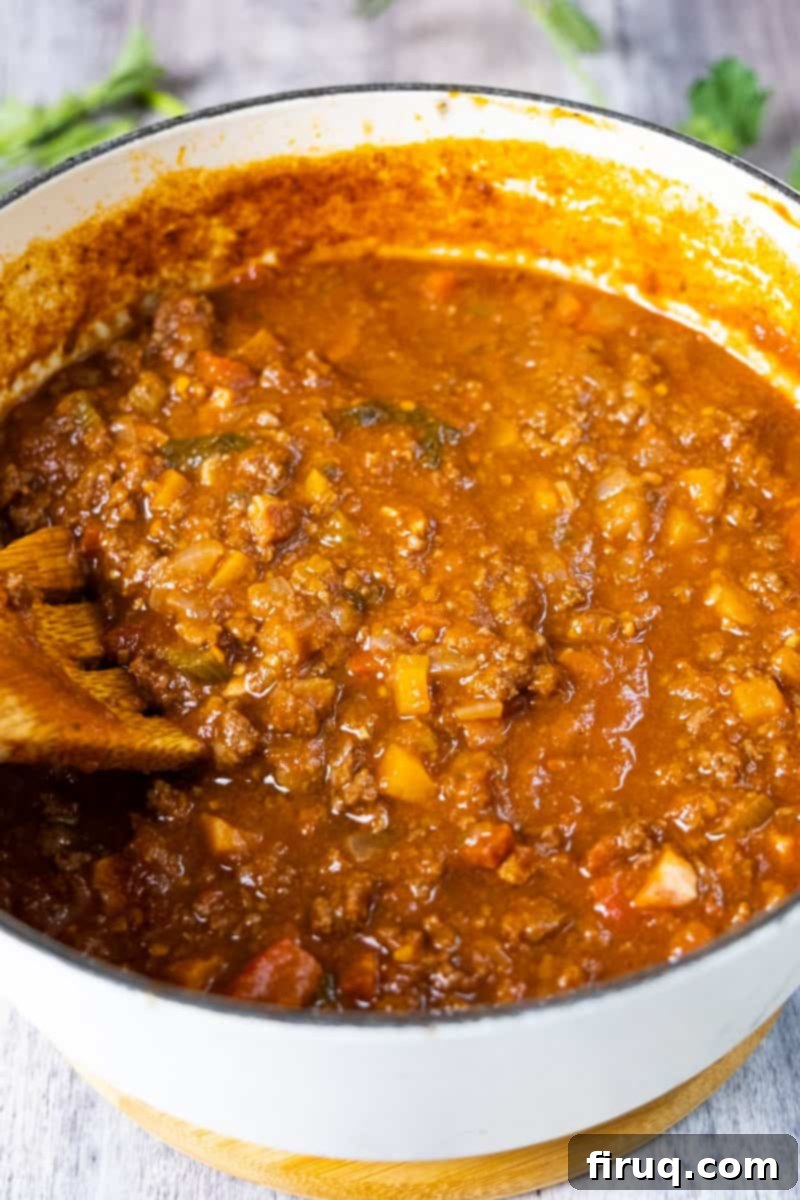
Storing and Reheating Your Bison Ragu
Bison ragu, like many slow-cooked sauces, often tastes even better the next day as the flavors continue to meld. It’s a fantastic dish for meal prepping or enjoying leftovers!
Storing Leftovers
- Refrigerator: Allow the ragu to cool completely before transferring it to an airtight container. It can be stored in the refrigerator for up to 3-4 days.
- Freezer: For longer storage, portion the cooled ragu into freezer-safe bags or containers. It can be frozen for up to 3 months. Thaw overnight in the refrigerator before reheating.
Reheating Instructions
Whether your ragu is already mixed with pasta or plain, reheating it properly will bring back its delicious warmth and flavor:
- On the Stovetop: Add the ragu to a small saucepan over medium-low heat. If it’s already mixed with pasta, that’s perfectly fine. As it heats, you might find it has thickened. Add a bit of water (or chicken/beef broth) and a drizzle of EVOO to loosen the sauce up and help it heat evenly. Stir occasionally until heated through.
- In the Microwave: For individual portions, place the ragu (with or without pasta) in a microwave-safe dish. Heat in 1-minute intervals, stirring in between, until piping hot. Add a splash of water or broth if it seems too dry.
Ragu is undeniably one of my all-time favorite dishes! The depth of flavor, the tender meat, and the comforting warmth make it a culinary masterpiece. If you tried and enjoyed this bison ragu, please do come back and leave a rating below! Your feedback means a lot, and I love hearing what you think of our dishes. Here are some other delicious braised meat recipes you might enjoy too:
More Delicious Braised Meat Recipes!
- Authentic Italian Braciole
- Easy Chicken Cacciatore
- Dutch Oven Barbacoa Tacos
- White Bean Pumpkin Chili
📖 Recipe
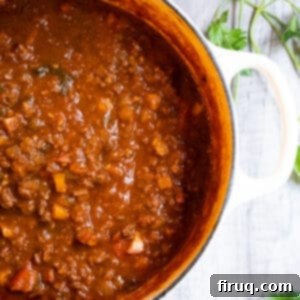
Bison Ragu
Vincent DelGiudice
Pin Recipe
Equipment
-
1 dutch oven or large saucepan
-
1 large pot
Ingredients
- 1 lb ground bison
- ¼ lb chopped pancetta
- 1 lb rigatoni or other pasta
- 1 28 oz can whole plum tomatoes
- 1 cup red wine
- ¾ cup chopped carrots, about 2 carrots
- ¾ cup chopped celery, about 2 celery stalks
- 1 cup chopped onion, about one medium onion
- 4 cloves garlic, minced
- 2 tbsp tomato paste
- 2 tbsp EVOO
- 1 handful basil
Instructions
-
In a large saucepan or Dutch oven on medium heat, add pancetta and fry until golden brown, stirring often. You want all sides of the pancetta to be golden brown. Once golden brown, use a slotted spoon to remove from the oil and set aside. Leave a small amount of oil behind and add 2 tablespoons of EVOO. Then stir in the onion, celery, and carrots. Add a pinch of salt and stir. Sauté the vegetables until soft and the onions translucent. Stir in the garlic and sauté for 2 more minutes until fragrant.
-
Add the ground bison directly to the vegetables. Break apart the bison with a spoon. Add a pinch of salt. Cook until just browned, stirring often. There will be some liquid that builds up in the pot; that’s normal, just keep stirring until it evaporates and the meat browns nicely. Add the tomato paste once the bison is browned and stir throughout, ensuring it coats everything. Allow it to cook and caramelize for 2-3 more minutes, stirring constantly. Then, add the red wine and bring it to a simmer. Simmer until the red wine is almost completely absorbed. It will take about 6-8 minutes.
-
Using your hands or an immersion blender, crush the plum tomatoes. Pour into the sauce and return the sauce to a simmer. Add the reserved crispy pancetta, fresh basil, and a pinch of salt. Simmer the sauce for 2-3 hours on low heat, slightly covered. If you notice it starts getting too dry, add a little bit of water or broth. Stir every 15 minutes or so to keep the bottom of the sauce from burning.
-
In a large pot, bring water to a boil. Add salt and your pasta. Boil as directed until al dente. Before draining, add ½ cup of pasta water to the ragu and stir. Then, drain your pasta and add it to the sauce, stirring until combined and coated. Serve immediately with grated Pecorino Romano cheese!
Notes
- Add the pancetta to the cold pan and bring it to medium heat to perfectly render the fat and get golden brown pancetta.
- Taste the sauce occasionally throughout the cooking process to see if more salt or other seasonings need to be added. It is normal to adjust seasoning as flavors develop.
Nutrition
Carbohydrates: 77g
Protein: 34g
Fat: 25g
Saturated Fat: 8g
Polyunsaturated Fat: 3g
Monounsaturated Fat: 12g
Trans Fat: 1g
Cholesterol: 74mg
Sodium: 295mg
Potassium: 823mg
Fiber: 5g
Sugar: 6g
Vitamin A: 3405IU
Vitamin C: 6mg
Calcium: 62mg
Iron: 4mg
